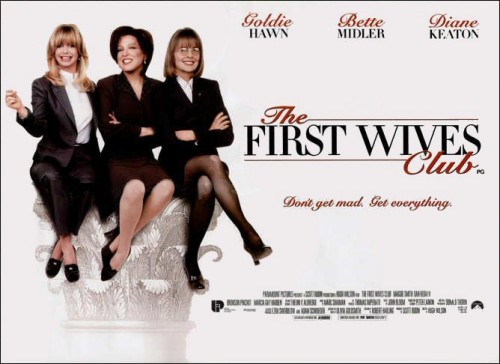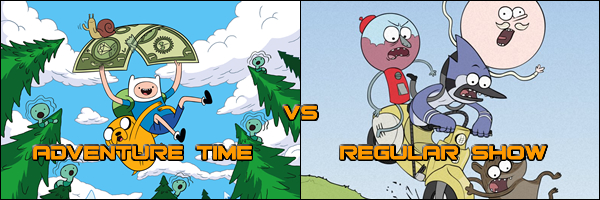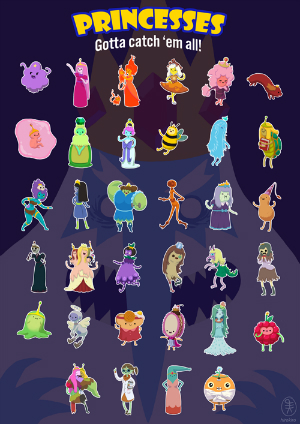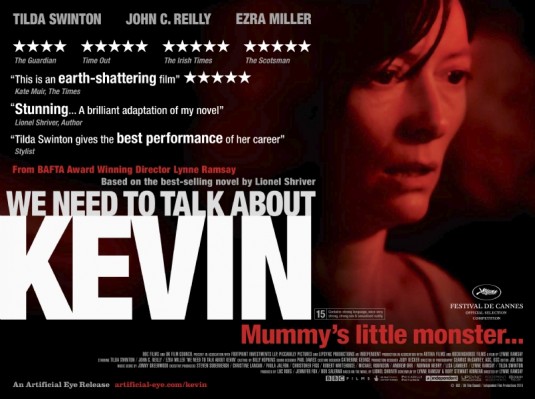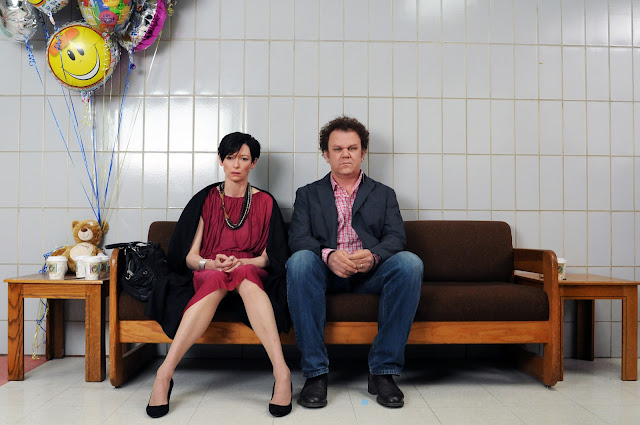This cross-post by Amanda Lyons previously appeared at her blog, Mrs. Meows Says, and appears as part of our theme week on Female Friendship.
In 1996, the year The First Wives Club was released, I was in my mid teens, and it felt like a good, hopeful time to be a young woman. Grunge and riot grrrl seemed to have ousted the need to conform to restrictive conventions of feminine fashion and behaviour. The music charts were full of talented and unique female artists. Movies and television were starting to show more complex, and sometimes even bad-ass, female characters. Looking back, I feel grateful to experience those difficult formative years in such a time.
It was definitely the right cultural climate for this film. I remember it was featured a lot in the media at the time – a story about a group of discarded first wives plotting revenge on their ungrateful ex-husbands definitely had a whiff of the zeitgeist about it. Indeed, so much so that the book was purchased by a movie studio before it was published as a novel. (The more hidebound publishing industry rejected the novel 26 times. I’m pretty sure I remember seeing the author, Olivia Goldsmith, on Oprah talking about this, saying that many of these publishers thought the male characters were portrayed “too negatively”.)
Though I thought this movie sounded like a positive cultural event, and quite possibly also a good wheeze, I missed it at the time. So when it happened to be playing on Foxtel on a recent cold Sunday night, I was more than happy to stay in the lounge with the gas heater all rugged up and warm and make up for my neglect.
What was I expecting? I guess a funny and entertaining revenge romp with a feminist punch? What did I get instead? Well, not that…
Probably the most entertaining thing about it was the long and delightful roll-call of actors I recognised from subsequent other things. Dan Hedaya! Victor Garber! Marcia Gay Harden! And of course the peerless Bronson Pinchot. Yay! That was good fun, and I was very glad they got to be part of something that would have given them a big boost at the time.
The next thing I noticed was the extremely overdone and intrusive score. Guys, I cannot believe this score was nominated for an Oscar. To me it felt like an obnoxious guest at a party who keeps grabbing your arm when you’re trying to talk to other people so he can tell you a really long and boring/offensive story that scares all other guests away from you. Hated it.
My second major hate: Diane Keaton, but I guess that’s probably more of a personal thing, although at least I know I’m not alone. I get why Woody Allen loved her so much – she’s totally the female version of him. Same schtick in every single role she plays: blinky, quirky, neurotic, and when she’s required to get emotional, shrieky. Also ineffably smug. Teeth-clenchingly annoying.
Next problem: the characters. Was this the fault of the script, the acting, or the direction? I would say an unholy collusion of all three. All the characters are shallow and unlikeable, including the women you are supposed to be rooting for. Nobody seems remotely like a real person – the husbands are drawn as dastardly cardboard villains, the first wives are shrieky caricatures, the second wives are completely one dimensional bimbos. The gags and one-liners are broad, awkward and the timing is just a little bit off every single time. The set pieces are cringey and the plot is just confusing. The revenge plots were a bit unclear and vague to me, as if the writers weren’t quite sure how to pull them off.
I think part of the frustration was that while the story was addressing a real and genuinely affecting issue – the culturally sanctioned discardability of women as they grow older – it opted to bury it inside a combination of broad slapstick and an extremely privileged, neo-liberal kind of feminism concerned solely with economic gain. I was somewhat in wonderment at the moneyed, ten-percenter world these women moved in. Of course separation, abandonment, betrayal, and heartbreak are a great leveller – all of us can suffer whatever our bank-balance. But the focus on “getting everything” was a little hard to stomach from women living in huge condos in the heart of New York with an interior designer on their payroll. Somehow it felt like the message was getting a little lost in the middle of all the high-society hob-nobbing – there was nothing particularly universal about it, and any feminism that was being communicated was certainly of a rarefied kind that most of us wouldn’t be able to access.
Perhaps key is the fact that the movie was written, directed and produced by men – or more specifically, men who shared the publishing world’s squeamishness about “man-bashing”. As producer Scott Rudin stated in The New York Times:
“When I took this on, I didn’t want a feminist manifesto, which it threatened to be,” he said. ”Initially, it made all the men terrible and was kind of anti-marriage. I didn’t want that. The film is really a satire. The amount of moaning and wailing is an object of satire. We’re not taking anything too seriously.”
Rudin, like so many others, accepted the fallacy conflating feminism with hating men rather than its simple belief that women and men “should have equal rights and opportunities.” That this conflation is so often promulgated is tiresome. It’s also tiresome that charges of “man-bashing”against films are so loud and strident when negative, and even harmful portrayals of women in film and television and everything are so commonplace we don’t even notice them most of the time. And the effect of this kind of distaste for anything remotely feminist in the stories we tell can cut the heart – and the ovaries -right out of them.
Feminism is not the only thing that’s diluted in the adaption of this story from book to movie – certainly the differences between the film and the book seem very revealing. For example, the complete excision of Annie’s (Diane Keaton) daughter’s Down Syndrome – she is turned into a lesbian, instead. (and the way she’s portrayed one sometimes wonders if the writers thought they were just swapping one disability for another??). This removes the onus for Brenda (Bette Midler) to become a lesbian herself, clearing the way for her to have a (SPOILER ALERT) reconciliation with her dastardly husband Morty, a strange and sudden reversal in the storyline of the film.
But one of the most interesting differences is how they choose to “avenge” their friend Cynthia, whose husband’s betrayal resulted in her suicide and provided the impetus for the first wives to reunite, rediscover their friendship and begin their club in the first place.
In the book, the women go after Cynthia’s husband and bring him down for insider trading, to his personal and financial ruin. But in the movie, the women decide that personal revenge is not noble enough – so instead they blackmail their ex-husbands into providing money to open a Crisis Centre for Women. This is a safe aspect of feminism; it’s hard to argue against helping the most vulnerable in society, and it’s easy in our culture to accept women in the role of victims – and indeed, the centre is named after their friend Cynthia Swann Griffin, the movie’s ultimate victim and sacrificial lamb.
The final scene – the opening party for the Crisis Centre – is intended to be the triumphal close to the movie, but instead it feels patronising and smug, the worst kind of charity. The party is ostentatious, opulent, and replete with the kind of economic excess that seems to cover the characters’ lifestyles like a thin film of oil. It is of course stuffed with the rich and fabulous, New York high society elite. There is a lot of back-slapping. Ivanka Trump appears, as well as Gloria Steinem, in a vague shout-out to “feminism.” There are no specifics discussed as to what kind of crises the centre will be helping women with, what kinds of women will be helped, or how. The husbands have been threatened with destruction but ultimately this female anger has been contained, and now the men are simply implored to open their pocketbooks. In the final scene the three women engage in a truly embarrassing song-and-dance routine, singing Lesley Gore’s “You Don’t Own Me” and dancing like your mum doing karaoke at your cousin’s 21st. The ultimate in Boomer smugness, and of course led by the inimitably irritating Diane Keaton.
In the novel, as the American Popular Culture Archive explains,
“Once the women decide to act, they exude power and energy. Brenda asks Elise, ‘Did anyone ever tell you you’re beautiful when you’re angry?’ Elise replies, ‘No. Mostly they liked me passive. But those days are over, my friend. I’m changing.'”
This movie adaption is, quite frankly, a mess, and seems to replace female power and agency with money. I’m no book adaption purist – I accept that the two mediums are different, and changes have to be made in translation. But in this case, it doesn’t seem that the changes were especially serving the ends of telling a story and preserving a message, so much as containing it to make it more marketable. But unfortunately the end result is clunky, unloveable, and not even entertaining. Perhaps it met the zeitgeist in 1996, but I think that it should probably stay there.
Amanda Lyons is a writer from Middle Earth (AKA New Zealand). By day she writes on finance, by night whatever takes her fancy at http://mrsmeowssays.blogspot.co.nz/.
